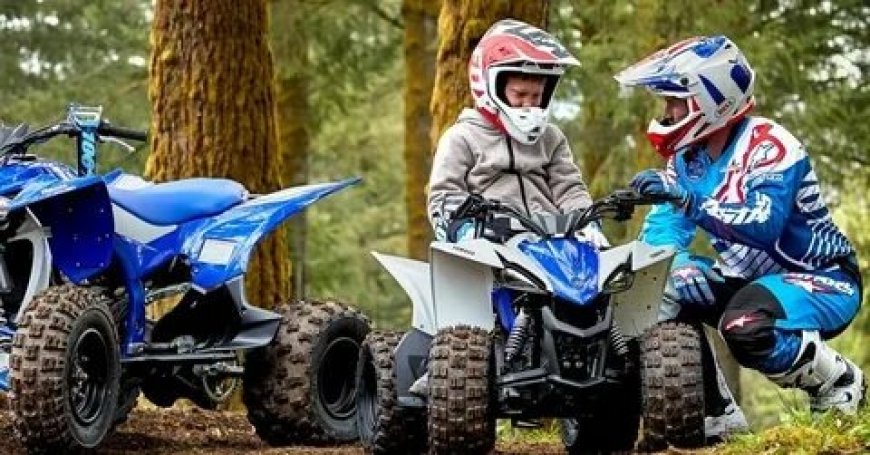ATV for Kids: What Lawmakers Are Debating Now

The rising popularity of ATV for kids has brought joy to many young riders and concern to parents and officials. While children enjoy the thrill of riding these machines, lawmakers are paying close attention to safety, regulation, and age-appropriate usage. Across various states, a legal debate is unfolding, focusing on what’s best for children’s safety without compromising their outdoor fun.
Why Are ATVs for Kids Gaining Attention?
Mini ATVs are becoming common among children, especially in rural areas and recreational parks. Many families see them as a fun way to spend time outdoors. These machines are now more accessible and affordable than before. As a result, many kids ride ATVs for sport, trail riding, or even small chores on family farms.
But this rise in use has sparked concern. Medical reports show an increase in accidents involving young ATV riders. Most injuries come from tipping over, collisions, or riding without safety gear. These incidents have forced lawmakers to re-evaluate whether current rules protect children well enough.
Lawmakers’ Primary Concerns Around ATV Use for Children
Safety Gear and Enforcement
One major focus is the lack of safety gear. Many kids ride without helmets, chest protectors, or knee pads. Lawmakers argue that stricter enforcement of helmet laws can reduce serious head injuries.
In some states, helmets are only recommended, not required. Officials are now pushing for mandatory safety equipment and regular safety checks on all ATVs used by minors.
Minimum Age Requirements
Age is another key issue. Some ATVs are designed for children as young as six. But are they really ready for such machines? Experts and lawmakers are discussing whether the minimum age for riding should be raised to 10 or 12.
They argue that many children lack the judgment and strength to control an ATV properly. Setting a stricter age limit could help lower accident rates significantly.
Supervision Rules
Supervised ATV riding is safer, yet many kids ride unsupervised in open areas. Lawmakers want to introduce laws that require adult supervision at all times for children under a certain age. Some states are also considering fines for guardians who allow young riders to go unsupervised.
Licensing and Training Programs
Some lawmakers suggest introducing training programs and basic licenses for young riders. These courses would teach children the rules of riding and the risks involved. Riders would earn a license after completing a short test. This could improve skills and reduce risky behavior.
States Taking the Lead in Changing ATV Laws
California
California is one of the strictest states when it comes to ATVs. Children under 14 can only ride if supervised by an adult with proper training. The state also requires safety certificates and full gear, including helmets and gloves.
Texas
Texas is considering new laws that include age restrictions and mandatory training. Legislators have proposed a bill to fine parents if their child is caught riding without safety equipment.
Pennsylvania
After a rise in ATV-related incidents, Pennsylvania lawmakers are proposing a rule to ban children under 10 from riding on public lands. They also want to limit ATV engine sizes for younger age groups.
Industry Reaction to These Debates
ATV manufacturers and outdoor groups have mixed feelings about these changes. While they agree on improving safety, many argue that some proposals go too far. Limiting engine sizes or raising age limits may affect sales and prevent responsible families from enjoying ATVs.
To address these concerns, some companies are updating their models. Newer versions come with speed governors, remote shut-off systems, and improved balance. These upgrades make ATV for kids safer without reducing fun.
What Pediatric Experts Are Saying
Doctors and child safety advocates strongly support stricter ATV regulations. According to pediatric reports, injuries from ATV crashes are among the top causes of trauma in children who live in rural areas.
Experts suggest that kids under 12 should not ride full-size ATVs. They recommend using smaller, speed-limited models and always riding under adult supervision.
Pediatricians are also asking for public awareness campaigns to educate parents. Many injuries occur because adults are unaware of the risks or assume ATVs are safe for all ages.
Key Features Parents Should Look For in a Kid’s ATV
As lawmakers work to improve laws, parents can take their own steps to keep their kids safe. Here are some key features to look for when buying an ATV for kids:
-
Speed Limiter: Helps control maximum speed for beginners.
-
Remote Kill Switch: Lets parents stop the engine from a distance.
-
Electric Start: Easier for kids to use than manual kick-starts.
-
Stability Features: Wider tires and lower seats for better balance.
-
Protective Gear Package: Brands that include helmets and pads add more value.
Choosing the right ATV with built-in safety features can reduce the risk of accidents and give parents peace of mind.
Role of Parents in Ensuring Safe ATV Use
Rules alone can’t solve the problem. Parents play a huge role in ensuring safe use of ATVs. They should:
-
Always supervise rides.
-
Educate children about the dangers of unsafe riding.
-
Set clear rules about where and how to ride.
-
Invest in training classes, even if they are not mandatory.
Parental involvement is often the missing piece in preventing ATV-related injuries.
How Schools and Communities Can Help
Schools can offer safety programs, invite guest speakers, or show videos that teach kids how to ride responsibly. Community centers can host ATV training workshops or awareness events.
Some rural schools already include ATV safety in their physical education or outdoor skills classes. If more areas followed this model, it would help build a culture of responsible riding from a young age.
Should All ATVs for Kids Be Banned?
This is one of the most heated questions in current debates. Some lawmakers and health groups suggest banning ATVs for children under 10. Others think education and safety rules are better options.
Banning them entirely may not be realistic, especially in areas where they are used for daily tasks or recreation. A balanced approach that combines law, technology, and education might be the most effective solution.
What’s Next for ATV Laws?
Many states are now reviewing current ATV laws. Some are setting up panels with doctors, parents, police, and outdoor experts to draft new rules. Others are waiting for more data on accident rates before making decisions.
Federal agencies are also keeping an eye on the issue. If state-level rules don’t improve safety, there could be a push for nationwide regulations in the future.
Moving Forward with Awareness and Responsibility
As discussions grow, one thing is clear—ATV for kids is not going away. These machines bring joy and adventure, but they also bring risks that cannot be ignored.
The path forward must involve responsible design, proper training, and updated laws. Parents, lawmakers, and manufacturers must work together to create a safer environment for young riders.
Instead of banning ATVs for kids, the focus should be on responsible ownership and informed choices. With the right balance of freedom and safety, children can enjoy riding while staying protected from harm.



























































































































































